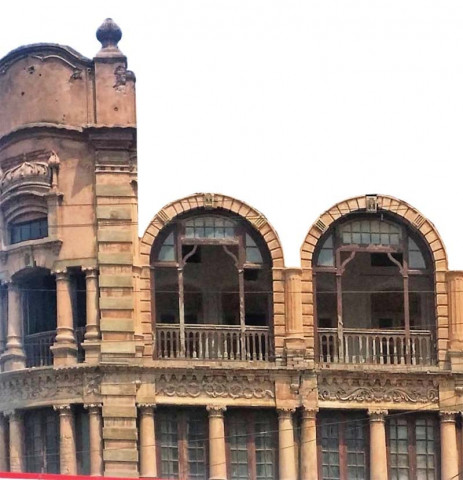Test of time: Ignorance eating away at Nowshera’s Taj
As the complex approaches its 100th birthday, it is left with few reasons to live on.

Masons arrive day in and day out to smother the intricate floral designs with helpings of cement. PHOTOS: EXPRESS
Back in the 1920s, a renowned landlord from Nowshera’s Badrashi village Khan Bahadur Taj Muhammad Khan decided to construct a building along GT Road that would catch the eyes of every individual who would zip through the iconic route. Labourers, architects and engineers were summoned instantly.
Khan Bahadur insisted on incorporating Oriental, Roman, Gothic and Islamic architectural aesthetics into making and the end product turned out to be just as grand as he had envisioned. He might have died a happy man but little did he know almost 100 years ago what the complex had in store. Time flew and the Taj building stood firm against the wind. Now that it is approaching its 100th birthday, the building is left with few reasons to live on. Invaded by a commercial bank, an inn, a motor mechanic workshop and a few general stores, the Taj is not even a shadow of what its name stands for. Besides the unwelcome guests, distasteful advertisement boards have covered the beauty like an unwanted veil. With its patched up face enmeshed in electrical wiring, the building yearns for room to breathe. Windowpanes have cracked one at a time and the wooden frames have been destroyed completely. While only archaeologists have the expertise to patch up historical buildings, masons arrive day in, day out to smother the intricate floral designs with helpings of cement.

There was a time when the Taj building was a safe haven for cinemagoers. Housing two film theatres where Pashto films would sell out within hours, the complex was once loved by Nowshera and its lively city life. The regal facility was also recently dragged into the corridors of the courts, with shopkeepers and current owner Tajul Mulk fighting over its ownership.
Ali Jan is a conservationist with a keen interest in historical buildings. Speaking to The Express Tribune, he said the colonial era complex needs fewer masons and more trained archaeologists who can carry out the restoration work with care. “This is only possible with the government declaring the building as national heritage.”
He said the vine patterns and floral decorations need safe hands to re-emerge out of the layers and layers of distasteful paint and grime. “The building has huge historical and architectural importance.”
Ali said his examination suggests things aren’t as bad as they seem. “Not much damage has been done and the building can be restored in its original state in no time.” He said if the government declares the building as state property under the Antiquities Act 1997, it will be much easier to operate. What’s devastating is that it’s not that the government never tried. According to an official, Taj was once notified as a protected building back in 2006, only to be de-notified without reason within six months. Working at one of the shops for years at end, Inam Khan recollects the times when he used to watch movies inside the building. “Here we witnessed the golden era of Pashto film.” Inam said the market for these movies was such that they would run three shows a day with people coming in from all over town.
Taj is perhaps not the only building that ignorance, at large, is eating away at. A general lack of interest towards preserving historical and iconic structures is prevalent across the province.
Published in The Express Tribune, August 31st, 2015.












COMMENTS
Comments are moderated and generally will be posted if they are on-topic and not abusive.
For more information, please see our Comments FAQ